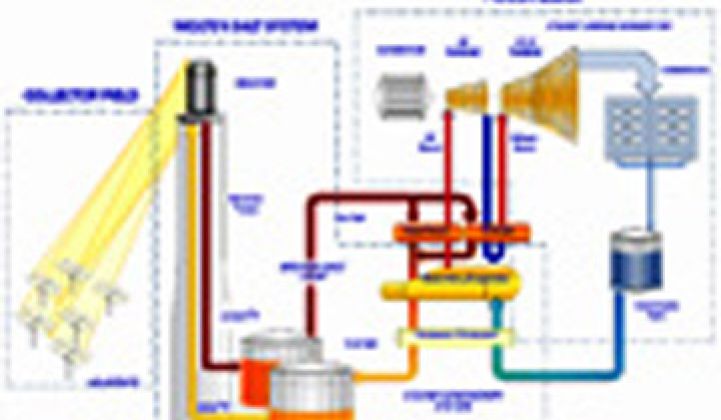SolarReserve moved one big step closer toward building a 110-megawatt solar thermal plant in Nevada: the DOE has granted it a $737 million loan guarantee.
The Santa Monica, Calif.-based company has created a solar thermal technology that uses heliostats -- relatively flat, independently mounted mirrors -- to focus the sun's heat on a large tank atop a 653-foot tower. But unlike the heliostat power plants designed by BrightSource Energy and e-Solar, SolarReserve's tank isn't filled with water. Instead, the system relies on a mix of molten sodium and potassium salts heated to 1,050 degrees Fahrenheit (565 degrees Celsius) to transfer heat from the heliostats to the power production unit at the plant.
Swapping out water for salt as a heat transfer fluid, SolarReserve argues, will allow it to match or top the output of the BrightSource Energy's Ivanpah plant and/or to increase the predictability of power production.
Salt also retains its heat longer than water, which means that SolarReserve can also produce power at night with its basic technology. BrightSource and others can add solar storage to their projects, but many now are choosing not in order to keep down the costs. (See full analysis of SolarReserve's technology here.)
The Nevada Public Utilities Commission approved the project last year. NV Energy will buy the power. Nevada Governor Brian Sandoval has also made it a mission to attract solar and geothermal plants to the state. SolarReserve also hopes to build a 150-megawatt plant in California.
Solar thermal is on a roll, at least with government officials and utilities. Earlier this year, the DOE issued a $2.1 billion loan guarantee to get the first 484 megawatts of a 1-gigawatt project spearheaded by Solar Trust (parent company of Solar Millennium) moving. The DOE has also issued loan guarantees to BrightSource Energy. Solar thermal power plants provide consistent, baseline-line power in large quantities. Some areas that are amenable to solar thermal plants enjoy 320 days or more of uninterrupted sun a year, according to Fred Morse, one of the world's foremost experts on thermal.
The two-decades-old solar thermal plants in California's Mojave Desert "have not missed one hour of peak output in their lifetime," Morse told us once. "When Mt. Pinatubo blew ash into the sky, they just burned a little more gas."
The downside: the costs for thermal plants aren't dropping as quickly as are the costs of solar plants made with photovoltaic cells. Concentrators could also continue to accelerate the cost declines of PV fields. Some believe that PV could become the more dominant technology.
Another issue: size. Solar thermal plants are generally larger -- SolarReserve's 110-megawatt plant is on the small size -- which means more permitting and environmental headaches. PV plants are more modular, allowing developers, potentially, to navigate bureaucratic circumstances.
In some ways, the technology is similar to the method that Tyco, Abengoa and Enel are using to replace therminol, the heat-carrying fluid in most parabolic trough systems, with molten salt to improve efficiency. The parabolic systems rely on a tube (instead of a tank) filled with a liquid, but the physics are the same.
SolarReserve's technology comes from United Technologies' Pratt & Whitney RocketDyne. It was developed and tested at Solar Two in the California desert during the 1990s.



